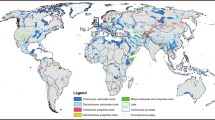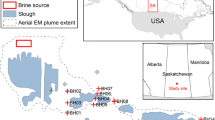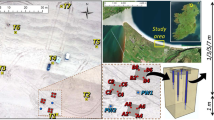Abstract
A workflow is described to estimate specific storage (S s) and hydraulic conductivity (K) from a profile of vibrating wire piezometers embedded into a regional aquitard in Australia. The loading efficiency, compressibility and S s were estimated from pore pressure response to atmospheric pressure changes, and K was estimated from the earliest part of the measurement record following grouting. Results indicate that S s and K were, respectively, 8.8 × 10−6 to 1.2 × 10−5 m−1 and 2 × 10−12 m s−1 for a claystone/siltstone, and 4.3 × 10−6 to 9.6 × 10−6 m−1 and 1 × 10−12 to 5 × 10−12 m s−1 for a thick mudstone. K estimates from the pore pressure response are within one order of magnitude when compared to direct measurement in a laboratory and inverse modelled flux rates determined from natural tracer profiles. Further analysis of the evolution and longevity of the properties of borehole grout (e.g. thermal and chemical effects) may help refine the estimation of formation hydraulic properties using this workflow. However, the convergence of K values illustrates the benefit of multiple lines of evidence to support aquitard characterization. An additional benefit of in situ pore pressure measurement is the generation of long-term data to constrain groundwater flow models, which provides a link between laboratory scale data and the formation scale.
Résumé
Un processus de travail est décrit pour estimer l’emmagasinement spécifique (S s ) et la conductivité hydraulique (K) à partir d’un profil de piézomètres à corde vibrante implantés dans un aquitard régional en Australie. L’efficacité de la charge, la compressibilité et Ss ont été estimés à partir de la réponse de la pression interstitielle à des modifications de pression atmosphérique, et K a été estimée à partir de la première partie de l’enregistrement des mesures suivant l’injection. Les résultats indiquent que S s et K, ont été respectivement de 8.8 × 10−6 à 1.2 × 10−5 m−1 et 2 × 10−12 m s−1 pour une argilite/siltite, et de 4.3 × 10−6 à 9.6 × 10−6 m−1 et 1 × 10−12 à 5 × 10−12 m s−1 pour un mudstone épais. Les estimations de K à partir de la réponse de la pression interstitielle sont d’un ordre de grandeur des mesures directes en laboratoire et des vitesses de flux déterminés par modèle inverse à partir des profils de traceurs naturels. Une analyse plus approfondie de l’évolution et de la longévité des propriétés des coulis de forage (par ex. effets thermiques et chimiques) peut aider à affiner l’estimation des propriétés hydrauliques de la formation en utilisant ce processus de travail. Cependant, la convergence des valeurs de K illustre le bénéfice de l’utilisation de plusieurs sources de données pour caractériser un aquitard. Un avantage supplémentaire des mesures de la pression in situ de la pression interstitielle est la production de données à long terme pour contraindre des modèles hydrodynamiques des eaux souterraines, ce qui permet d’établir un lien entre les données de laboratoire et celles à l’échelle de la formation.
Resumen
Se describe un diagrama de flujo para estimar el almacenamiento específico (S s) y la conductividad hidráulica (K) a partir de un perfil de piezómetros de cuerda vibrante incrustado en un acuitardo regional en Australia. Se estimaron la eficiencia de carga, compresibilidad y S s a partir de la respuesta de la presión poral a cambios de presión atmosférica, y K fue estimado a partir de la parte más temprana del registro de mediciones posteriores a la cementación. Los resultados indican que S s y K fueron, respectivamente, 8.8 × 10−6 a 1.2 × 10−5 m−1 y 2 × 10−12 m s−1 para una arcilita/limolita, y 4.3 × 10−6 a 9.6 × 10−6 m−1 y 1 × 10−12 a 5 × 10−12 m s−1 para una fangolita espesa. Las estimaciones de K a partir de la respuesta de la presión poral están dentro de un orden de magnitud cuando se las compara a mediciones directas en el laboratorio y a tasas de flujo de modelado inverso determinado a partir de perfiles de trazadores naturales. Un análisis más detallado de la evolución y longevidad de las propiedades del pozo cementado (por ejemplo efectos químicos y termales) puede ayudar a ajustar la estimación de las propiedades hidráulicas de la formación usando este diagrama de flujo. Sin embargo, la convergencia de los valores de K ilustra el beneficio de múltiples líneas de evidencias para apoyar a la caracterización del acuitardo. Un beneficio adicional de la medición de la presión poral in situ es la generación de datos a largo plazo para restringir los modelos de flujo de agua subterránea, lo cual proporciona una vínculo entre los datos a escala de laboratorio y la escala de formación.
摘要
本文论述了估算澳大利亚区域隔水层中振弦测压计剖面单位储水量(S s)和水力传导率(K)的工作流程。通过孔隙压力对大气压力变化的反应估算了加载效率、压缩率及单位储水量,同时也根据灌浆后最早的测量记录估算了水力传导率。结果显示,单位储水量和水力传导率在粘土岩、粉砂岩中分别为8.8 × 10−6 到 1.2 × 10−5 m−1 和 2 × 10−12 m s−1,在泥岩中分别为4.3 × 10−6 到 9.6 × 10−6 m−1 和 1 × 10−12 to 5 × 10−12 m s−1 。与实验室直接测量结果和天然示踪剂剖面确定的反向模拟通量比较后发现,根据孔隙压力反应得到的水力传导率估算值处在一个数量级内。利用这个工作流程,有关钻孔泥浆特性(即热效应和化学效应)演化和寿命的进一步分析可有助于提高地层水力特性的估算精度。然而,水力传导率值的收敛阐明了证据多重线在支持隔水层特性描述中的优点。现场孔隙压力测量的另外一个优点就是不断积累长期资料,用来约束地下水模型,这些资料的产生搭建了实验室尺度资料和地层尺度资料之间的桥梁。
Resumo
É descrito um fluxograma de trabalho para estimar o armazenamento específico (S s) e a condutividade hidráulica (K) a partir de um perfil de piezômetros de corda vibrante embutidos num aquitardo regional, na Austrália. A eficiência de carga, a compressibilidade e o S s foram estimados a partir da resposta da pressão dos poros às mudanças da pressão atmosférica, e o K foi estimado a partir da parte inicial do registro de medição na sequência da cimentação. Os resultados indicam que S s e K foram, respetivamente, 8.8 × 10−6 a 1.2 × 10−5 m−1 e 2 × 10−12 m s−1 para um argilito/siltito, e 4.3 × 10−6 a 9.6 × 10−6 m−1 e 1 × 10−12 a 5 × 10−12 m s−1 para uma espessa formação de lamito. As estimativas de K obtidas a partir das respostas da pressão nos poros são de uma ordem de magnitude quando comparadas com medições diretas em laboratório e com taxas de fluxo baseadas em perfis de traçadores naturais e obtidas por modelação inversa. Análises posteriores da evolução e longevidade das propriedades do cimento do furo (por exemplo efeitos térmicos e químicos) podem ajudar a refinar a estimação das propriedades hidráulicas da formação, usando este fluxograma de trabalho. No entanto, a convergência dos valores de K ilustra o benefício de linhas de evidência múltiplas para apoiar a caraterização do aquitardo. Um benefício adicional das medições da pressão de poros in situ é a geração de dados de longo prazo para constranger os modelos de fluxo de água subterrânea, o que providencia uma ligação entre os dados à escala de laboratório e à escala da formação.







Similar content being viewed by others
References
America Society for Testing Materials (ASTM) (2009) Standard test methods for laboratory determination of density (unit weight) of soil specimens. West Conshohocken, PA, International D7263-09. doi:10.1520/D7263-09
America Society for Testing Materials (ASTM) (2010) Standard test methods for Laboratory Determination of Water (Moisture) Content of Soil and Rock by Mass, West Conshohocken, PA, International D2216-10. doi:10.1520/D2216-10
Anochikwa CI, van der Kamp G, Barbour SL (2012) Interpreting pore-water pressure changes induced by water table fluctuations and mechanical loading due to soil moisture changes. Can Geotech J 49:357–366. doi:10.1139/t11-106
Barr AG, van der Kamp G, Schmidt R, Black TA (2000) Monitoring the moisture balance of a boreal aspen forest using a deep groundwater piezometer. Agric For Meteorol 102:13–24. doi:10.1016/s0168-1923(00)00094-0
Bethke CM, Zhao X, Torgersen T (1999) Groundwater flow and the He-4 distribution in the Great Artesian Basin of Australia. J Geophys Res Solid Earth 104:12999–13011
Bredehoeft JD, Neuzil CE, Milly PC (1983) Regional flow in the Dakota aquifer: a study of the role of confining layers. US Geological Survey Water-Supply Paper 2237. U. S. G. P. O., Reston, VA, p 45
Bredehoeft JD, Djevanshir RD, Belitz KR (1988) Lateral fluid flow in a compacting sand-shale sequence: south Caspian basin. AAPG Bull 72:416–424
Butler JJ, Zhan X, Zlotnik VA (2007) Pumping-induced drawdown and stream depletion in a leaky aquifer system. Ground Water 45:178–186. doi:10.1111/j.1745-6584.2006.00272.x
Contreras IA, Grosser AT, Ver Srate RH (2008) The use of the fully-grouted method for piezometer installation. Geotech News 26:30–40
Dewhurst DN, Aplin AC, Sarda J-P, Yang Y (1998) Compaction-driven evolution of porosity and permeability in natural mudstones: an experimental study. J Geophys Res Solid Earth 103:651–661. doi:10.1029/97jb02540
Dewhurst DN, Aplin AC, Sarda JP (1999) Influence of clay fraction on pore-scale properties and hydraulic conductivity of experimentally compacted mudstones. J Geophys Res Solid Earth 104:29261–29274. doi:10.1029/1999jb900276
Eaton TT, Bradbury KR (2003) Hydraulic transience and the role of bedding fractures in a bedrock aquitard, southeastern Wisconsin, USA. Geophys Res Lett 30. doi: 10.1029/2003gl017913
Escoffier S, Homand F, Giraud A, Hoteit N, Su K (2005) Under stress permeability determination of the Meuse/Haute-Marne mudstone. Eng Geol 81:329–340. doi:10.1016/j.enggeo.2005.06.020
Freytag IB (1966) Proposed rock units for marine lower cretaceous sediments in the Oodnadatta Region of the Great Artesian Basin. Q Geol Notes 18:3–7
Gardner WP, Harrington GA, Smerdon BD (2012) Using excess He-4 to quantify variability in aquitard leakage. J Hydrol 468:63–75. doi:10.1016/j.jhydro1.2012.08.014
Hantush MS (1960) Modification of the theory of leaky aquifers. J Geophys Res 65:3713–3725. doi:10.1029/JZ065i011p03713
Harrington GA, Gardner WP, Smerdon BD, Hendry MJ (2013) Palaeohydrogeological insights from natural tracer profiles in aquitard porewater, Great Artesian Basin, Australia. Water Resour Res 49:4054–4070. doi:10.1002/wrcr.20327
Hart DJ, Bradbury KR, Feinstein DT (2006) The vertical hydraulic conductivity of an aquitard at two spatial scales. Ground Water 44:201–211. doi:10.1111/j.1745-6584.2005.00125.x
Hart DJ, Bradbury KR, Gotkowitz MB (2008) Is one an upper limit for natural hydraulic gradients? Ground Water 46:518–520. doi:10.1111/j.1745-6584.2008.00433.x
Hasegawa T, Nakata K, Oyama T (2008) Research and development of groundwater dating (part 8): validation on 36Cl dating method to characterize low permeable layer. Civil Engineering Research Laboratory, Report no. N07038, CERL, Abiko, Japan
Hendry MJ, Wassenaar LI (2009) Inferring heterogeneity in aquitards using high-resolution dD and d18O profiles. Ground Water 47:639–645
Hendry MJ, Wassenaar LI (2011) Millennial-scale diffusive migration of solutes in thick clay-rich aquitards: evidence from multiple environmental tracers. Hydrogeol J 19:259–270. doi:10.1007/s10040-010-0647-4
Hendry MJ, Barbour SL, Zettl J, Chostner V, Wassenaar LI (2011) Controls on the long-term downward transport of delta H-2 of water in a regionally extensive, two-layered aquitard system. Water Resour Res 47. doi: 10.1029/2010wr010044
Jiang Z, Mariethoz G, Taulis M, Cox M (2013) Determination of vertical hydraulic conductivity of aquitards in a multilayered leaky system using water-level signals in adjacent aquifers. J Hydrol 500:170–182. doi:10.1016/j.jhydrol.2013.07.030
Keller CK, Vanderkamp G, Cherry JA (1989) A multiscale study of the permeability of a thick clayey till. Water Resour Res 25:2299–2317. doi:10.1029/WR025i011p02299
Konikow LF, Neuzil CE (2007) A method to estimate groundwater depletion from confining layers. Water Resour Res 43, W07417. doi:10.1029/2006wr005597
Long D, Hobbs PRN (1979) Geotechnical properties of sediments from borehole 77/75 (North Sea). Report 79/4, British Geological Survey, Edinburgh
Mazurek M, Alt-Epping P, Bath A, Gimmi T, Waber HN, Buschaert S, De Canniere P, De Craen M, Gautschi A, Savoye S, Vinsot A, Wemaere I, Wouters L (2011) Natural tracer profiles across argillaceous formations. Appl Geochem 26:1035–1064. doi:10.1016/j.apgeochem.2011.03.124
McKenna GT (1995) Grouted-in installation of piezometers in boreholes. Can Geotech J 32:355–363. doi:10.1139/t95-035
Mikkelsen PE (2002) Cement-bentonite grout backfill for borehole instruments. Geotech News 20:38–42
Moore PS, Pitt GM (1984) Cretaceous of the Eromanga basin: implication for hydrocarbon exploration. APEA J 24:358–376
Moore PS, Pitt GM, Dettmann ME (1986) The Early Cretaceous Coorikiana Sandstone and Toolebuc Formation: their recognition and stratigraphic relationship in the southwestern Eromanga Basin. In: Gravestock DI, Moore PS, Pitt GM (eds) Contributions to the geology and hydrocarbon potential of the Eromanga Basin. Geol Soc Australia Spec Pub 12:97–114
Neuman SP, Witherspoon PA (1972) Field determination of the hydraulic properties of leaky multiple aquifer systems. Water Resour Res 8:1284–1298. doi:10.1029/WR008i005p01284
Neuzil CE (1986) Groundwater flow in low-permeability environments. Water Resour Res 22:1163–1195. doi:10.1029/WR022i008p01163
Neuzil CE (1993) Low fluid pressure within the Pierre Shale: a transient response to erosion. Water Resour Res 29:2007–2020. doi:10.1029/93wr00406
Neuzil CE (1994) How permeable are clays and shales? Water Resour Res 30:145–150. doi:10.1029/93wr02930
Post V, Kooi H, Simmons C (2007) Using hydraulic head measurements in variable-density ground water flow analyses. Ground Water 45:664–671. doi:10.1111/j.1745-6584.2007.00339.x
Radke BM, Kellett JR, Ransley TR, Bell JG (2012) Lexicon of the lithostratigraphic and hydrogeological units of the Great Artesian Basin and its Cenozoic cover: a technical report to the Australian Government from the CSIRO Great Artesian Basin Water Resource Assessment. CSIRO Water for a Healthy Country Flagship, South Clayton, Australia, 163 pp
Reece JS, Flemings PB, Dugan B, Long H, Germaine JT (2012) Permeability-porosity relationships of shallow mudstones in the Ursa Basin, northern deepwater Gulf of Mexico. J Geophys Res 117:B12102. doi: 10.1029/2012jb009438
Rousseau-Gueutin P, Love AJ, Vasseur G, Robinson NI, Simmons CT, de Marsily G (2013) Time to reach near-steady state in large aquifers. Water Resour Res 49:6893–6908. doi:10.1002/wrcr.20534
Schulze-Makuch D, Carlson DA, Cherkauer DS, Malik P (1999) Scale dependency of hydraulic conductivity in heterogeneous media. Ground Water 37:904–919. doi:10.1111/j.1745-6584.1999.tb01190.x
Simeoni L (2012) Laboratory tests for measuring the time-lag of fully grouted piezometers. J Hydrol 438–439:215–222. doi:10.1016/j.jhydrol.2012.03.025
Skempton AW (1954) The pore-pressure coefficients A and B. Geotechnique 4:146–147
Smith JE (1971) The dynamics of shale compaction and evolution of pore-fluid pressures. Math Geol 3:239–263. doi:10.1007/bf02045794
Smith LA, van der Kamp G, Hendry MJ (2013) A new technique for obtaining high-resolution pore pressure records in thick claystone aquitards and its use to determine in situ compressibility. Water Resour Res 49:732–743. doi:10.1002/wrcr.20084
Therrien R, McLaren RG, Sudicky EA, Panday SM (2009) HydroGeoSphere: a three-dimensional numerical model describing fully-integrated subsurface and surface flow and solute transport. Groundwater Simulations Group, University of Waterloo, Waterloo, Canada
Timms WA, Acworth RI (2005) Propagation of pressure change through thick clay sequences: an example from Liverpool Plains, NSW, Australia. Hydrogeol J 13:858–870. doi:10.1007/s10040-005-0436-7
Van Camp M, Vauterin P (2005) TSOFT: graphical and interactive software for the analysis of time series and Earth tides. Comput Geosci 31:631–640
van der Kamp G (2001) Methods for determining the in situ hydraulic conductivity of shallow aquitards: an overview. Hydrogeol J 9:5–16. doi:10.1007/s100400000118
van der Kamp G, Gale JE (1983) Theory of earth tide and barometric effects in porous formations with compressible grains. Water Resour Res 19:538–544
van der Kamp G, Maathuis H (1991) Annual fluctuations of groundwater levels as result of loading by surface moisture. J Hydrol 127:137–152
van der Kamp G, Schmidt R (1997) Monitoring of total soil moisture on a scale of hectares using groundwater piezometers. Geophys Res Lett 24:719–722
Vaughan PR (1969) A note on sealing piezometers in boreholes. Geotechnique 19:405–413
Wickman FE (1954) The “total” amount of sediments and the composition of the “average igneous rock”. Geochim Cosmochim Acta 5:97–110
Yang YL, Aplin AC (1998) Influence of lithology and compaction on the pore size distribution and modelled permeability of some mudstones from the Norwegian margin. Mar Pet Geol 15:163–175. doi:10.1016/s0264-8172(98)00008-7
Yang YL, Aplin AC (2007) Permeability and petrophysical properties of 30 natural mudstones. J Geophys Res Solid Earth 112, B03206. doi:10.1029/2005jb004243
Yu L, Rogiers B, Gedeon M, Marivoet J, Craen MD, Mallants D (2013) A critical review of laboratory and in-situ hydraulic conductivity measurements for the Boom Clay in Belgium. Appl Clay Sci 75–76:1–12. doi:10.1016/j.clay.2013.02.018
Acknowledgements
The authors are thankful for the field and laboratory assistance provided by Andrew Taylor (CSIRO), Virginia Chostner (University of Saskatchewan), and Andrew Love (Flinders University of South Australia), as well as Norm Sims (Anna Creek Station manager) and the landowners of pastoral leases on which drilling was completed. This study was funded in part by the Australian Government National Water Commission’s Groundwater Action Plan, administered through the South Australian Arid Lands Natural Resources Management Board and Flinders University, and in part by CSIRO Water for a Healthy Country National Research Flagship. Funding was also provided to M. Jim Hendry (University of Saskatchewan) by NSERC-IRC to support Laura Smith and Virginia Chostner. The authors also thank Garth van der Kamp, David Hart, an anonymous reviewer, and the associate editor for constructive comments on an earlier version of this manuscript.
Author information
Authors and Affiliations
Corresponding author
Rights and permissions
About this article
Cite this article
Smerdon, B.D., Smith, L.A., Harrington, G.A. et al. Estimating the hydraulic properties of an aquitard from in situ pore pressure measurements. Hydrogeol J 22, 1875–1887 (2014). https://doi.org/10.1007/s10040-014-1161-x
Received:
Accepted:
Published:
Issue Date:
DOI: https://doi.org/10.1007/s10040-014-1161-x




